This post contains affiliate links, which means I may earn a commission if you purchase through those links (at no extra cost to you).
I grew up making Orange Marmalade the old-fashioned way: soaking citrus overnight and boiling it rigorously to extract the natural pectin in the rind. When you follow my technique, you don’t need to add any store-bought pectin, and you get the best, cleanest-tasting marmalade.
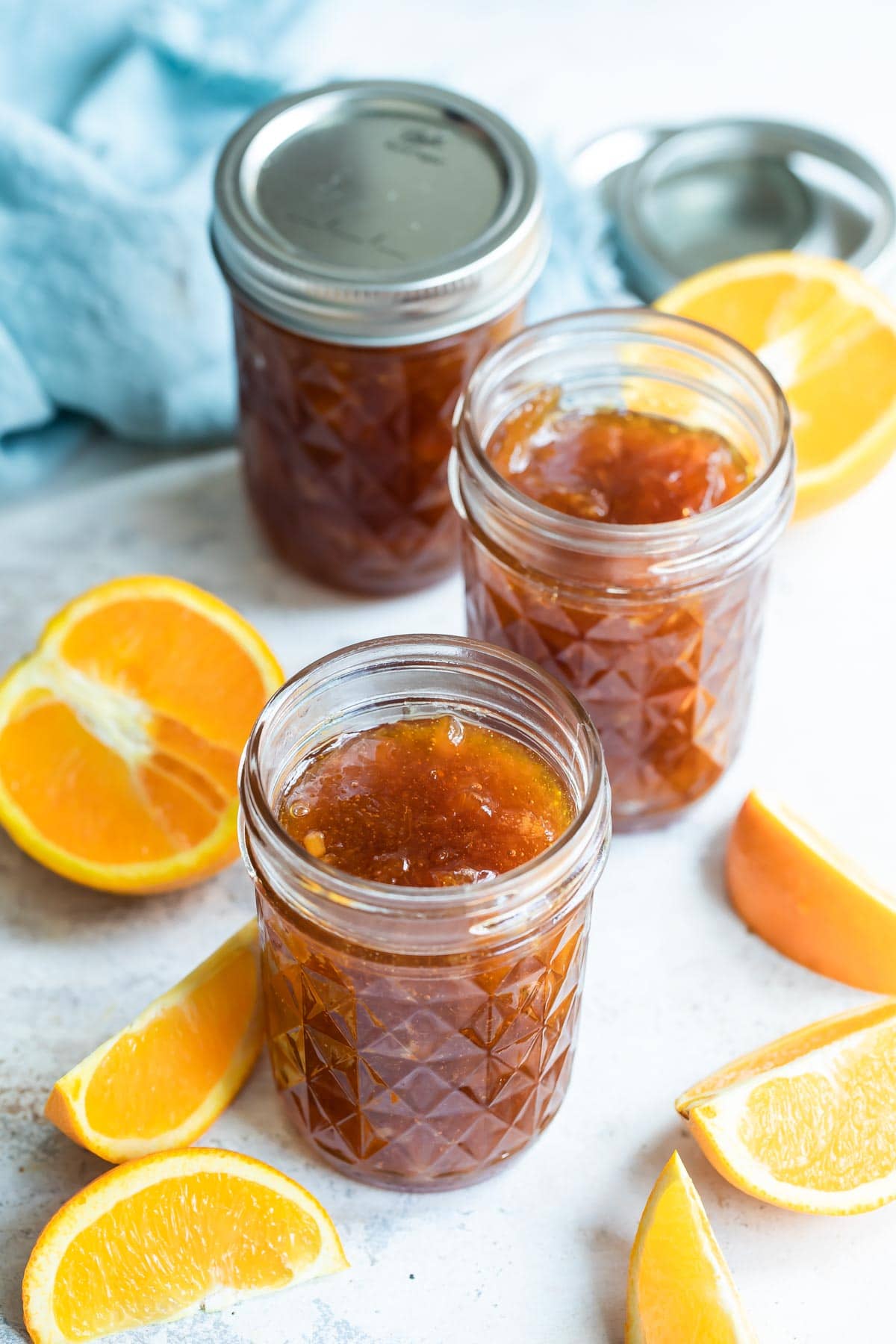
Nearly 1,000 5-star reviews prove this unfussy technique is simple and easy to follow. I also include my handy “cold plate test” so you can know for sure whether your marmalade is done or needs a little bit more time on the stove.
Home cooks everywhere are putting their abundant citrus to use to make their own homemade marmalade, and now you can, too. This recipe makes about 3 quarts total, or 12 (8 ounce jars). It freezes beautifully or you can process it in a water bath for canning.
Table of Contents
Marmalade Ingredients
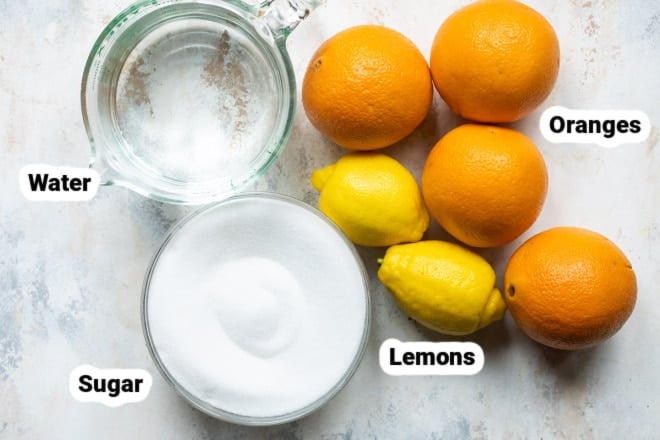
At a Glance: Here is a quick snapshot of what ingredients are in this recipe.
Please see the recipe card below for specific quantities.
- Oranges: This recipe is made with regular seedless oranges. You can definitely substitute Seville oranges if you can find them. They are only in season from the end of January to mid-February, but they have an intense flavor that is ideal for marmalade.
How to make Orange Marmalade
- Using a sharp knife, cut oranges and lemons in half crosswise, then into very thin half-moon slices. Discard any seeds. In a large pot (stainless steel), add the sliced oranges, lemons, and any fruit juice.
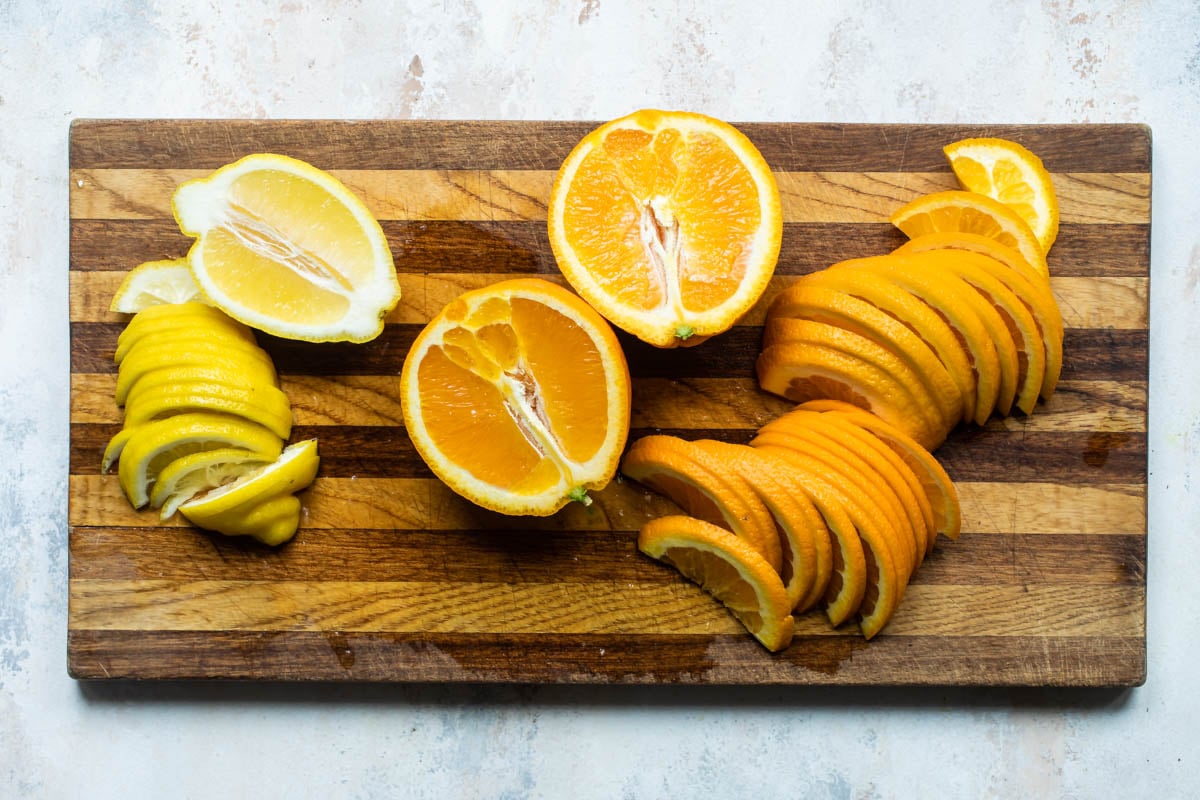
- Add water and bring the mixture to a boil over medium heat, stirring often. Remove from the heat and stir in the sugar until it dissolves. Cover and let stand overnight at room temperature.
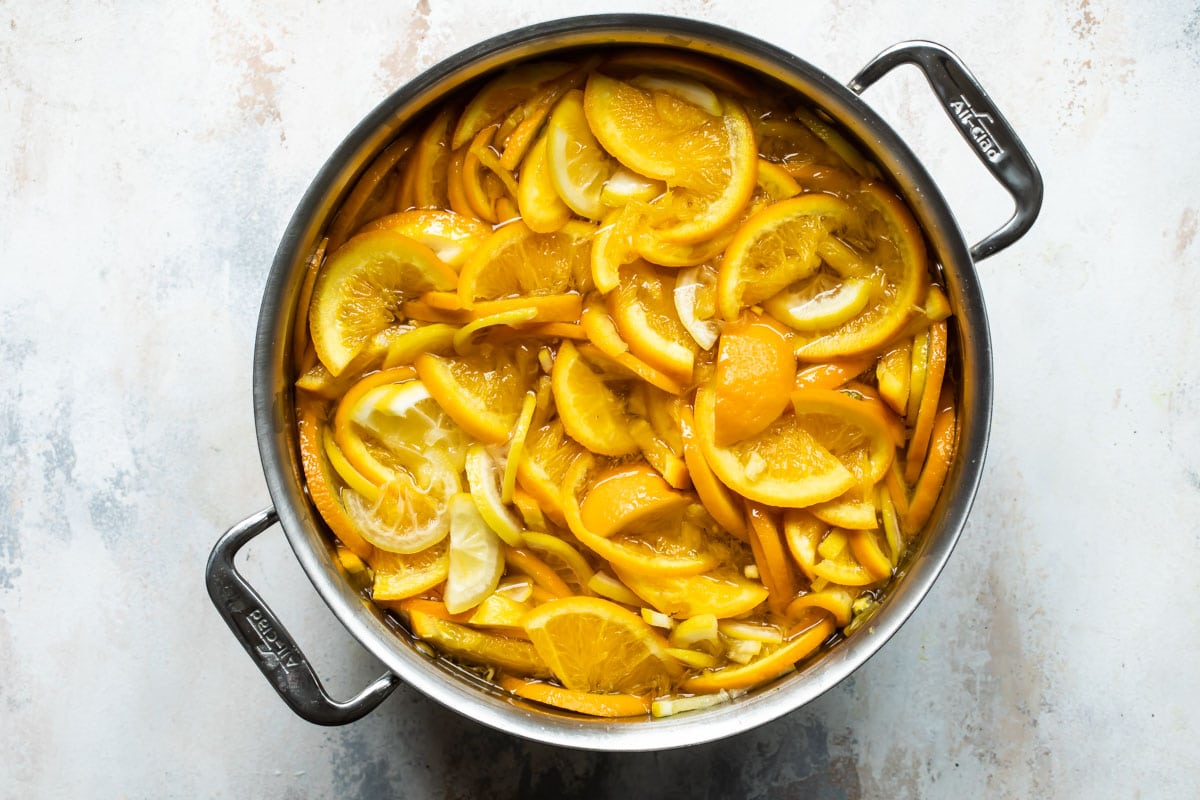
- The next day, bring the mixture back to a boil in the pot or saucepan. Reduce heat to low and simmer uncovered for 2 hours. Turn heat up to medium and boil gently, stirring often, for another 30 minutes. Skim off any foam that forms on the top. Cook until it reaches 220 degrees on a candy thermometer (you must hit this temperature for the natural pectin to gel with the sugar).
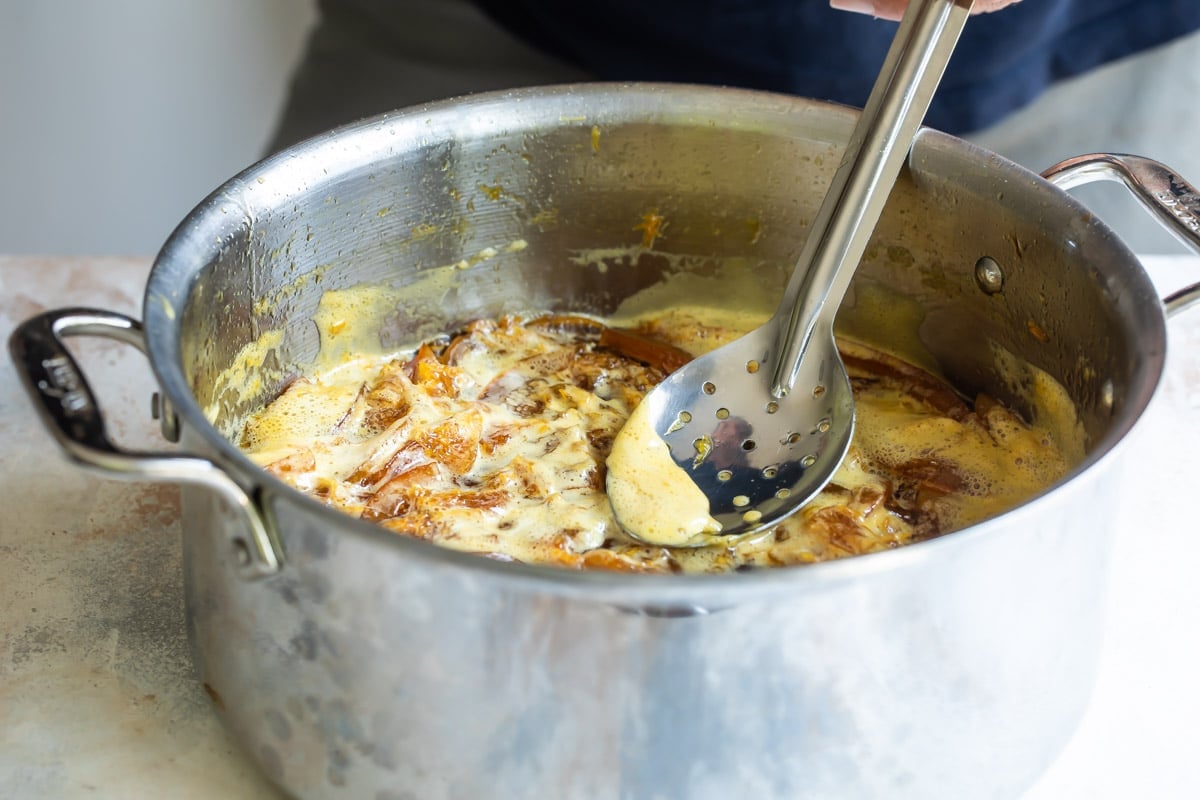
- To test if the marmalade is ready, place a small amount on a plate and refrigerate it until it’s cool but not cold. If it’s firm (neither runny nor hard), it’s ready. It will be a golden orange color. If it’s still runny, continue cooking it; if it’s hard, add a bit more water.
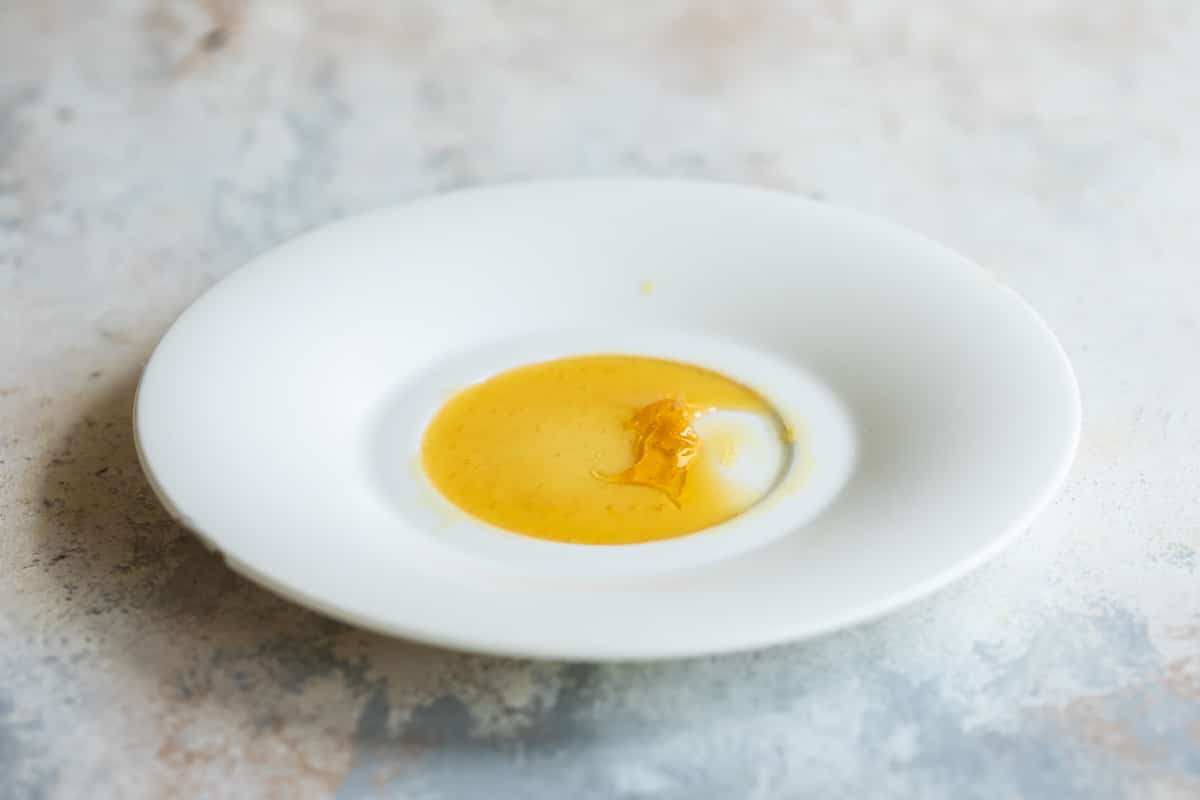
- Pour or ladle the marmalade into clean hot mason jars (I use this wide-mouth jar funnel for this recipe and so many others). Wipe the rims thoroughly with a clean damp paper towel, and seal with the lids. Chill in the refrigerator. It may take 24-48 hours for the natural pectin to set up properly.
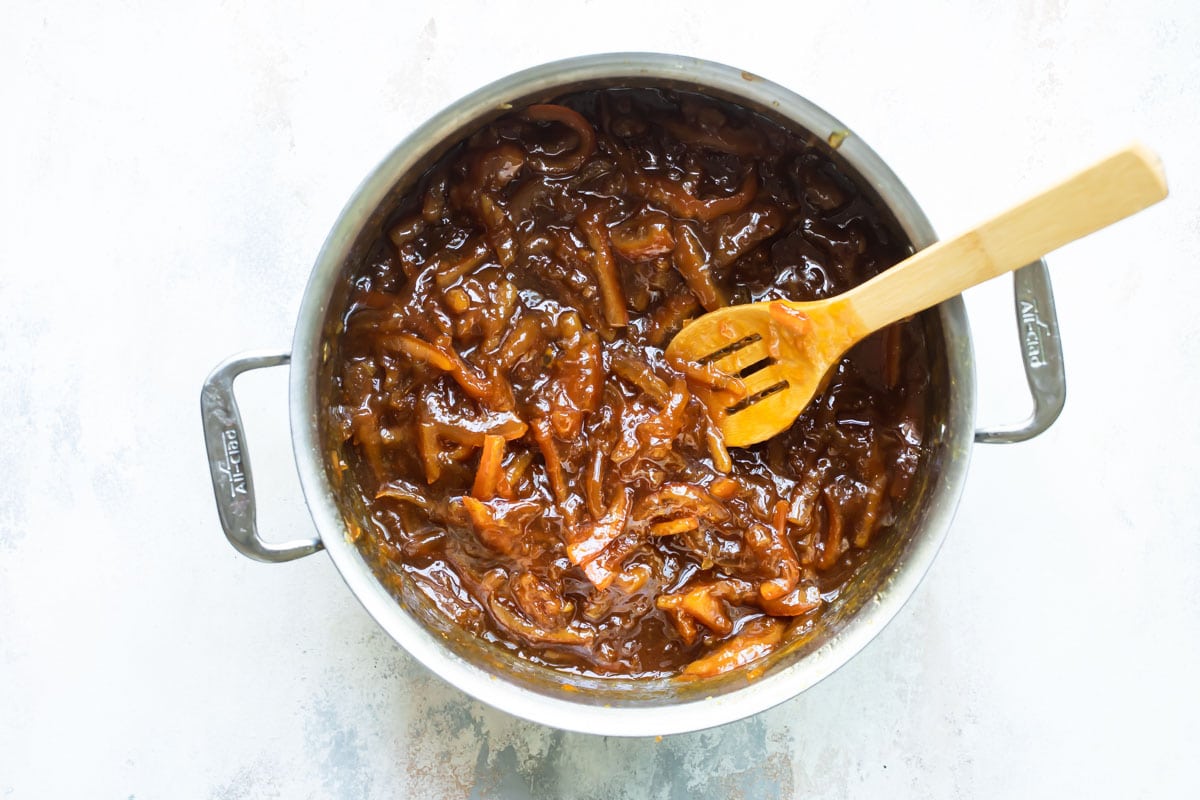
Orange Marmalade Recipe Variations
- Pectin: While many jam and jelly recipes require added pectin, you don’t need to add any here. Pectin is naturally concentrated in the pith of the orange (the bitter white part under the peel). This recipe coaxes out that natural pectin by letting the citrus soak overnight and then boiling it rapidly until enough water has evaporated that the mixture can reach 220 degrees.
- Agave nectar: Agave cannot penetrate and sweeten the peel as well as sugar can. When I tested it, the consistency was fine, but the rind tasted like raw rind. I don’t recommend this substitution.
- Low sugar: I haven’t tested low-sugar/alternative sweeteners in this recipe other than agave as listed above nor have I tweaked the amount of sugar in the recipe. I recommend seeking out recipes from experts in that area.
- Slow cooker: While it is technically possible to make marmalade in your slow cooker, it really depends on the power of your appliance. I no longer recommend that method because it isn’t reliable enough.
- Instant pot: Even with an overnight soak, the IP doesn’t break down the rind sufficiently. I don’t recommend this method.
Marmalade Recipe Tips
- Yield: This recipe makes about 3 quarts (96 ounces) of marmalade.
- If using 1/2-pint (8 ounce) jars, you’ll need 12.
- If using 1 pint (16 ounce) jars, you’ll need 6.
- If using the tiny jelly jars (4 ounce), you’ll need 24.
- Cold-plate test: To test if your marmalade is ready, spoon some hot marmalade on to a small plate and put it in the freezer to chill, or spoon some over an icy cold plate fresh from the freezer. If the mixture wrinkles slightly when you draw a spoon or finger across it, it has reached the setting point and is ready to go! If not, keep boiling and make sure the temperature reaches 220 degrees.
- Set-up time: Orange marmalade takes 24-48 hours for the natural pectin to set up completely. If it’s is still a little runny looking when it cools, check again in a day or two.
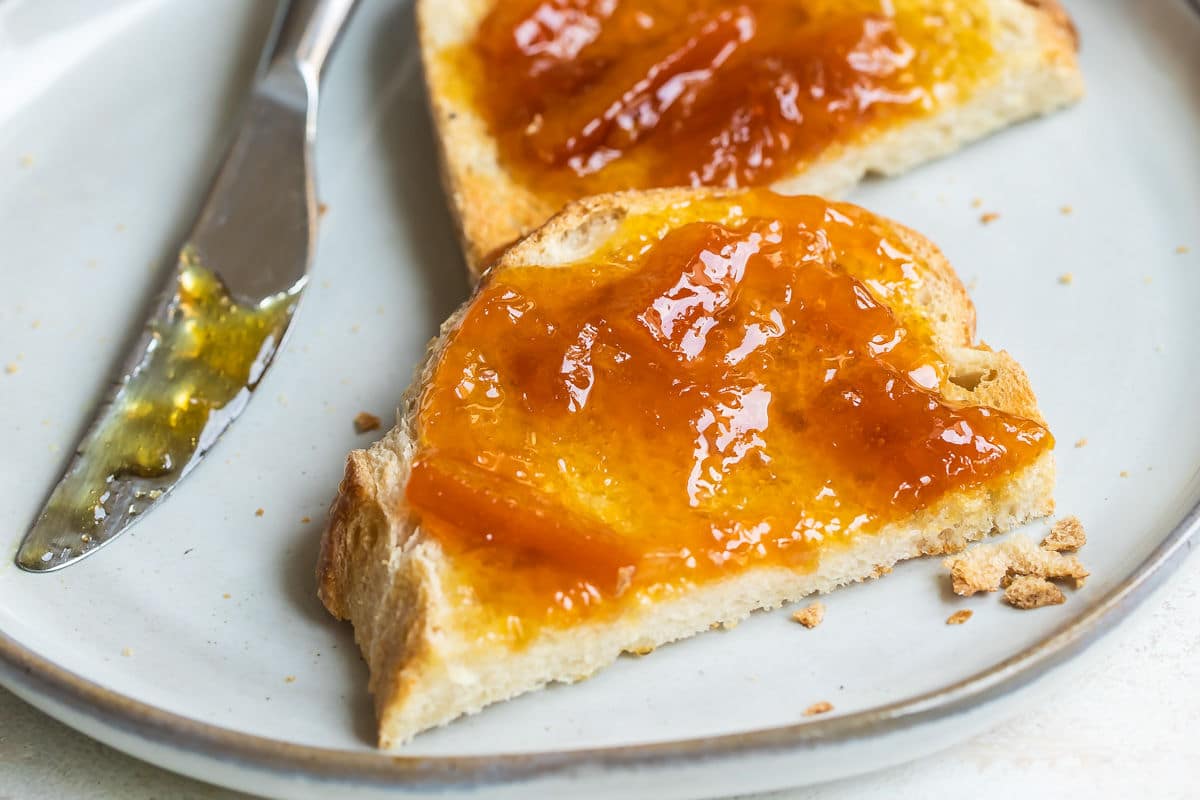
Storing and Canning Orange Marmalade
Storage: Store covered in the refrigerator for up to 1 month.
Freezer: Pack in freezer-safe containers or jars leaving 1/2-inch of headspace for expansion. Label, date, and freeze for up to 3 months. Thaw overnight in the refrigerator.
Canning: If putting up for storage, use a hot water or steam canner with a rack to properly seal lids on canning jars according to canning instructions. Otherwise, refrigerate and use within the month. Or, freeze for up to 3 months.
Frequently Asked Questions
Pectin is naturally concentrated in the pith of the orange (the bitter white part under the peel), so you don’t need to add any here. This recipe coaxes out that natural pectin by letting the citrus soak overnight and then boiling it rapidly until enough water has evaporated that the mixture can reach 220 degrees.
While it is technically possible to make marmalade in your slow cooker, it really depends on the power of your appliance. I no longer recommend that method because it isn’t reliable enough.
Even with an overnight soak, the IP doesn’t break down the rind sufficiently. I don’t recommend this method.
Agave cannot penetrate and sweeten the peel as well as sugar can. When I tested it, the consistency was fine, but the rind tasted like raw rind. I don’t recommend this substitution.
I don’t recommend making this recipe in a regular cast iron pan. It should be made in a non-reactive pan. Enameled cast iron, stainless steel, and non-stick are best and will not affect the color or taste of the marmalade
More fruit recipes
Pie and Tart Recipes
Fresh Fruit Tart
Fruit Dessert Recipes
Apple Crisp with Oatmeal
Cake Recipes
Lemon Bundt Cake Recipe
Muffins and Quick Breads
Banana Muffins
Join Us

Orange Marmalade
Equipment
- Jar funnel (for wide mouth jars)
Ingredients
- 4 large seedless oranges scrubbed clean (about 3 pounds or 8 cups slices, see note 1)
- 2 lemons (about ½ pound or 1 cup slices)
- 8 cups water
- 8 cups granulated sugar
Instructions
- Cut oranges and lemons in half crosswise, then into very thin half-moon slices. Discard any seeds. In a large stainless steel pot, add the sliced oranges, lemons, and any accumulated juices.
- Add water and bring the mixture to a boil, stirring often. Remove from the heat and stir in the sugar until it dissolves. Cover and let stand overnight at room temperature.
- The next day, bring the mixture back to a boil. Reduce heat to low and simmer uncovered for 2 hours. Turn heat up to medium and boil gently, stirring often, for another 30 minutes.
- Skim off any foam that forms on the top. Cook the marmalade until it reaches 220 degrees (you must hit this temperature for the natural pectin to gel with the sugar).
- To test if the marmalade is ready, place a small amount on a plate and refrigerate it until it's cool but not cold (see note 4). If it's firm (neither runny nor hard), it's ready. It will be a golden orange color. If the marmalade is runny, continue cooking it; if it's hard, add a bit more water.
- Pour the marmalade into clean hot mason jars; wipe the rims thoroughly with a clean damp paper towel, and seal with the lids. Chill in the refrigerator. It may take 24-48 hours for the natural pectin to set up properly.
Recipe Video
Notes
- Oranges: This recipe is made with regular seedless oranges. You can definitely substitute Seville oranges if you can find them. They are only in season from the end of January to mid-February, but they have an intense flavor that is ideal for marmalade.
- Yield: This recipe makes about 3 quarts (96 ounces) of marmalade.
- If using 1/2-pint (8 ounce) jars, you’ll need 12.
- If using 1 pint (16 ounce) jars, you’ll need 6.
- If using the tiny jelly jars (4 ounce), you’ll need 24.
- Storage: Store covered in the refrigerator for up to 1 month.
- Cold-plate test: To test if your marmalade is ready, spoon some hot marmalade on to a plate and put it in the freezer to chill, or spoon some over an icy cold plate fresh from the freezer. If the mixture wrinkles slightly when you draw a spoon or finger across it, it has reached the setting point and is ready to go! If not, keep boiling and make sure the temperature reaches 220 degrees.


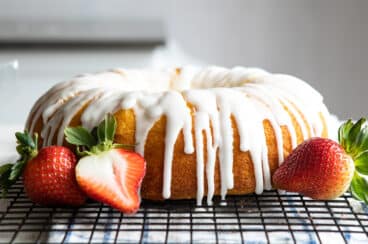
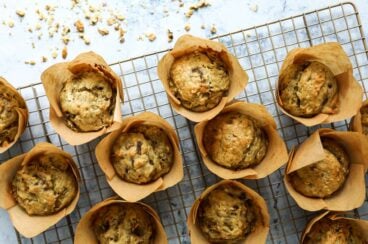
This is the first time I’ve ever made marmalade. Made it for my mother and she loves it!
So easy to do and looks really pretty as well. Thanks for sharing.
Hi, please can you clarify how many liters are the 8 cups of water in this recipe? And 8 cups of sugar in kilograms please?
Hi Dominika, 8 cups of water is 1.892 liters, and 8 cups granulated sugar is 1.6 kilograms. Take care! – Meggan
Also, sorry for the second comment Megan but I did also make the same error I read below and accidentally put the water and sugar in at the same time before cooking/boiling the first day. Turned out perfect anyway, so thankful this recipe is so forgiving!
I just finished my first batch… LOVE IT! I doubled it and because we grow sweet Satsumas that’s what I used. When I doubled it I used about 20-25 TRIMMED oranges because the card small with thicker ends and 4 oranges. Also to answer a question I read in the comments, I did verrry thinly sliced about 5-7 oranges and all lemons, I put all the remaining peels in my mini food processor and ground/chopped them, it worked beautifully and saved me countless hours of tiny slicing! Looks great in the finished product too! Highly recommend this recipe, I’m making my 2nd doubled batch now! Last one made 11 pints, but I’m going to do these in smaller jars for gifting! Love, love, love!
Sorry should say 20-25 TRIMMED oranges and 4 lemons!
Thank you SO much for this FANTASTIC recipe! This was my first time making marmalade! I used all oranges (no lemons) and gave a splash of lemon juice instead. I also added a scant handful of crushed green cardamom pods to the overnight soak and next day simmer.I had to the fish the husks out but the flavor was worth it, and the remaining black seeds look pretty in the jar! Thanks again!
Hi! Do I need to let the jars sit for 24 hours before I steam can them for storage?
Hi Sarah, no, you don’t have to wait at all. Once you’ve done the “plate test” to ensure it’s at the right consistency, you can divide it into jars and process them for storage immediately. Thank you! -Meggan
The best orange marmelade I ever had
Thank you for sharing your recipe .
Hello, Can this be made with coconut sugar instead?
Hi Tandra, I haven’t tried using coconut sugar, so I can’t say it will for sure. Sorry about that! I did try it with agave syrup instead of sugar and it didn’t turn out well. If you do try it, please let me know how it turns out! – Meggan
Great recipe. Thanks for the hint about coming to 220 degrees. Now in saying it is great, I will tell you I changed it. I used satsumas from my tree, used satsuma juice instead of water, cut the sugar to 3 cups and 1 cup of splenda and a handful of dried stevia leaves (again from my garden). It is plenty sweet and the rinds are soft. It set perfectly. I think I could cut the sugar by one more cup. Will do that next time since I do not need to make anymore for this year.
I have a stevia plant… I am of course wanting to use it for tea and etc… I am assuming you used the leaves whole and then took them out after cooking process ….is that correct? thank you
I just finished making a batch with 4 homegrown oranges and 2 large lemons. It appears like a moderate fail so far. It’s brown instead of pretty orange, not actually sure if it got to 220 degrees F because the meat thermometer took to long to work (so have to buy a candy thermometer. Does it “get any sweeter” after setting up? First impression is that its not very sweet at all despite all that sugar. If not, I’ll call it “2020’s Bitter End – Marmalade.” Plenty more on the tree to give it another shot, maybe one I chose wasn’t ripe enough.